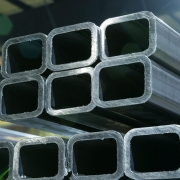Hollow Structural Sections (HSS): A Comprehensive Guide
Introduction
Hollow Structural Sections (HSS) have emerged as essential components in various engineering and construction applications. Their unique design, which includes square, rectangular, and circular profiles, makes them suitable for a wide range of structural uses. This blog will delve into the characteristics of HSS, and their applications in infrastructure, marine engineering, and green energy, while also discussing relevant material standards like ASTM A500, ASTM A1085, EN 10219-1, and EN 10210-1.
What Are Hollow Structural Sections?
HSS are steel shapes characterized by hollow profiles, providing both strength and versatility. They are widely utilized in various construction and engineering fields due to their numerous advantages, including resistance to torsion, uniformity in strength, and aesthetic appeal.
Types of HSS
Square Sections: Offer equal dimensions on all sides, providing uniform structural strength.
Rectangular Sections: Provide versatility in design, accommodating various load requirements.
Circular Sections: Ideal for applications requiring rounded shapes, such as columns.
Advantages of HSS
High Strength-to-Weight Ratio
HSS structures can support significant loads while being lightweight, facilitating easier transportation and installation.
Uniform Strength
The hollow design provides consistent strength in all directions, making HSS suitable for dynamic loading scenarios.
Aesthetic Flexibility
HSS can be easily integrated into architectural designs, providing a modern look while serving structural purposes.
Corrosion Resistance
HSS can be treated to enhance resistance to environmental factors, making them ideal for outdoor and marine applications.
Applications of HSS
1. Infrastructure
In infrastructure projects, HSS is commonly used for:
Building Frames: Offering structural support for various types of buildings, from residential to commercial.
Bridges: Providing strength and minimizing weight, which is critical for structural integrity.
2. Marine Engineering
In marine environments, HSS proves beneficial due to:
Durability: Withstanding harsh conditions like saltwater exposure.
Piling and Foundations: Used extensively in the construction of docks, piers, and offshore platforms.
3. Green Energy
In the green energy sector, particularly in wind turbine applications, HSS is vital for:
Wind Turbine Towers: Supporting the weight of turbines while ensuring stability in high winds.
Foundations: Offering a robust base for turbines, essential for long-term reliability.
Relevant Material Standards
Understanding the standards associated with HSS is crucial for ensuring compliance and safety. Here are key standards and their relevant grades:
ASTM A500
Description: This standard covers cold-formed welded and seamless carbon steel structural tubing in round, square, and rectangular shapes.
Grades: Includes Grade A (minimum yield strength of 35 ksi), Grade B (minimum yield strength of 46 ksi), and Grade C (minimum yield strength of 50 ksi).
ASTM A1085
Description: This standard specifies cold-formed welded and seamless carbon steel structural tubing requirements, designed for improved performance.
Grades: It requires a minimum yield strength of 50 ksi and a minimum tensile strength of 65 ksi, suitable for demanding structural applications.
EN 10219-1
Description: This European standard covers the technical delivery conditions for cold-formed welded and non-welded structural hollow sections.
Grades: Various grades are defined based on yield strength, including S235JRH, S275J0H/J2H, and S355J0H/J2H, each offering different mechanical properties.
EN 10210-1
Description: This standard specifies the requirements for hot-finished structural hollow sections.
Grades: Similar to EN 10219, it includes grades such as S235JRH, S275J0H/J2H, and S355J0H/J2H, emphasizing the importance of yield strength in structural integrity.
Conclusion
Hollow Structural Sections are integral to modern construction and engineering, providing strength, versatility, and aesthetic appeal. Their applications span across infrastructure, marine engineering, and green energy, making them essential for sustainable and resilient design.
Understanding the relevant material standards, such as ASTM A500, ASTM A1085, EN 10219-1, and EN 10210-1, ensures that engineers and architects can select the appropriate HSS for their projects, meeting safety and performance requirements.
As you explore the possibilities of HSS in your next project, consider consulting with structural engineers to ensure optimal design and compliance with industry standards. This will not only enhance the integrity of your structures but also support sustainable development in various fields.


